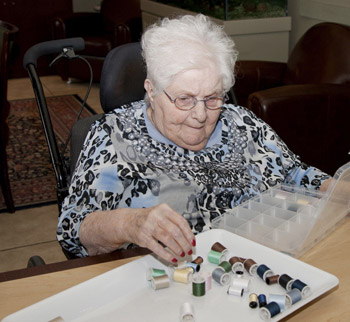TORONTO — A children’s educational program, developed more than 100 years ago by Dr. Maria Montessori, and recently adapted for people with dementia, has vastly improved the quality of life for some residents of L’Chaim Retirement Home.
Since introducing the Montessori method for dementia to the Sheppard Avenue West home this past winter, owner Judy Cohen says she has seen a remarkable change in many residents.
About 90 per cent of L’Chaim’s 30 residents have dementia.
With the help of consultant Carol Saba, who is trained in the Montessori method for dementia, said Cohen, the entire home – all staff attended a two-day workshop – has embraced the method, and has changed the approach in which they deal with residents.
“By engaging residents in meaningful activities, we are seeking the person behind the dementia,” she said.
Upon entering the home, changes are evident, said Cohen. “We’ve painted murals on entrance and exit doors so instead of being enticed to escape through the doors, residents admire the art work.”
Saba said there is a lot of environmental cuing. They bypass declarative memory, the recall of facts and knowledge, and concentrate on procedural memory, the act of doing something. “Procedural memories [are often] retained after declarative memory is lost. Many tasks, such as reading, can be retaught.”
“We post daily schedules, which remind residents of tasks such as bathroom visits or meals.
“Residents who constantly ask about a daily walk may forget that they just returned from their walk. A schedule that shows when they last walked and when the next walk occurs can be very helpful,” said Saba.
They have also created memory books, with pictures provided by families, she said, that draw on past life experiences.
Cohen said specific roles and routines, make residents feel that they are contributing to society.
“One woman loves folding towels, and others match coloured clothespins to bowls, or visit the “glamour exchange” where they can borrow jewelry or try on hats for Shabbat.
“Carol works one-on-one with residents to determine their needs, strengths and abilities, and then finds activities that address these needs. The emphasis is always on demonstrating tasks instead of using words.
“One woman who did not speak, started to sing and speak when she was presented with a baby doll.”
She said that concentrating on a task helps people with memory loss feel more secure.
Cohen is dedicated to keeping the method going, she said, and demonstrate that people’s lives can be changed. “We want the community to know that it is out there. All caregivers can be trained.”
